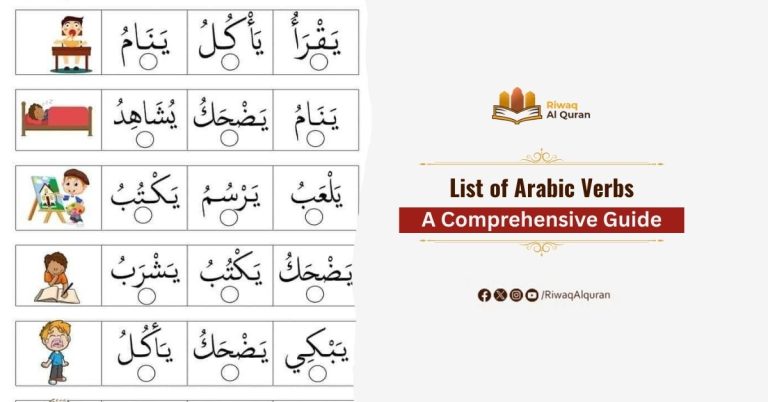Idgham is one of the major rulings of Tajweed [the set of rules governing the correct pronunciation and recitation of the Quran in Arabic]. In Tajweed, Idgham is to combine two sounds into one sound. There are two main types of Idgham: Idgham with Ghunnah and Idgham without Ghunnah.
In this article, we will examine, in a nutshell, the meaning of Idgham. Then, we will explore the two types of Idgham: Idgham with Ghunnah and Idgham without Ghunnah. To understand these two types well, we will define Ghunnah and how to pronounce it. We will also point out the letters of each of these two types along with some examples from the Quran and everyday Arabic spoken language.
Table of Contents
Idgham In Tajweed
Linguistically, Idgham means to inter something into another thing. In Tajweed, Idgham is to combine two sounds into one sound, making a stressed sound [double sound]. The first letter must be Sakin (ساكن) [with a Sukon (ْ) above it or with nothing above or under it] and the second one must be Mutahrik (متحرك) [with a Fataha (َ), Kasra (ِ), or Dammah (ُ)].
The letters of Idgham are 6:
ي – ر– م – ل –و – ن
They are combined in the Arabic word يرملون.
Definition Of Ghunnah In Tajweed
Ghunnah is a nasal sound that is produced when someone utters the sound of the letter Meem (م) or the letter Noon (ن) from the nose for approximately two seconds [i.e. 2 Harakat]. Ghunnah is an essential fundamental characteristic of these two sounds, if it is not done for any reason, they will sound completely different.


How To Pronounce Ghunnah In Tajweed?
A perfect Ghunnah is naturally made whenever you pronounce the letter Meem (م) or the letter Noon (ن). However, let’s break down the process into three main steps:
1- Place the tip of your tongue lightly on the roof of your mouth (just behind the upper front teeth) for the letter Noon “ن” or gently touch your lips together for the letter Meem “م”.
2- Produce a soft, nasal sound by allowing air to flow through your nose. You do not need to make a forceful sound, but the nasal quality should be clearly audible.
3- Ensure the sound is prolonged, but not overly long. It is typically a short, clear nasal sound (lasting for about 2 counts or beats).
Key Points To Remember
Practicing Ghunnah involves carefully controlling your breath and tongue position, and it is best to listen to experienced reciters to perfect your technique. However, keep the following points in mind when pronouncing it:
1- Ghunnah is always a soft nasal sound.
2- It is not harsh, but should be distinctly audible.
3- It is a crucial part of proper Tajweed for correct Quran recitation.
Idgham With Ghunnah And Idgham Without Ghunnah
There are two main types of Idgham: Idgham with Ghunnah and Idgham without Ghunnah. Now, let’s examine both of them, highlighting the letters of each type and some examples from the Quran and everyday Arabic speech.
What Is Idgham With Ghunnah?
Idgham with Ghunnah is a rule in Tajweed that refers to the merging of two letters, where the first letter is Noon Sakinah (نْ or ن) or Tanween [like double Fataha (ً), double Dammah (ٌ) and double Kasra (ٍ)] and the second letter is one of the letters of Idgham that require a nasal sound (Ghunnah) during the merging process.
Letters Of Idgham With Ghunnah
Idgham with Ghunnah comes with 4 of the letters of Idgham: They are combined in the Arabic word ينمو. So they are ي – ن – م – و. To be correct, this sound needs to be 50% from the mouth and 50% from the nose. That’s why it is called Idgham with Ghunnah.
Idgham With Ghunnah Examples
There are so many examples of this type of Idhgam, both in the Quran and in everyday Arabic speech. Let’s see just one example for each.
An Example From The Quran:
“وَمَن يَعْمَلْ مِثْقَالَ ذَرَّةٍۢ شَرًّۭا يَرَهُۥ”
Here the Noon (ن) sound in the Tanween of the word (شرَّا) is dropped and changed into a double [stressed] ي and a Ghunnah is made.
An Example From Everyday Arabic Speech:
“من نَفسه”
The word “من” ends with Noon Sakinah and is followed by Noon Mutahrikah (نَ) in the next word “نَفسه”. So the first Noon (ن) sound is dropped and the second Noon (نَ) is stressed with Ghunnah.
Read more about: Idgham Kamil Vs Idgham Naqis
What Is Idgham Without Ghunnah?
Idgham without Ghunnah is a rule, in Tajweed, where the Noon Sakinah (نْ or ن) or Tanween is followed by one of the specific letters of Idgham that do not require a nasal sound (Ghunnah) during the merging process.
In this case, the Noon Sakinah or the Noon sound of the Tanween is merged with the following sound, but there is no nasal sound produced. The merging occurs smoothly, and the Ghunnah is dropped.
Letters Of Idgham Without Ghunnah
This type of Idgham comes with the remaining 2 letters of Idgham letters: ل and ر. To be correct, this sound needs to be 100% from the mouth. That’s why it is called Idgham without Ghunnah.
Idgham Without Ghunnah Examples
There are many examples of this type of Idhgam as well, in the Quran and in everyday Arabic speech. Let’s see below one example for each of these contexts.
An Example From The Quran:
“وَحَنَانًۭا مِّن لَّدُنَّا وَزَكَوٰةًۭ ۖ وَكَانَ تَقِيًّۭا”
Here the Noon (ن) sound in (من) is dropped and no Ghunnah is made. So here there is no trace of ن sound heard at all, neither from the mouth nor from the nose.
An Example From Everyday Arabic Speech:
“طفلٌ لطيف”
The word “طفلٌ” has Tanween followed by the letter ل in the next word “لطيف”, so the second part of the Tanween: Noon (ن) sound is dropped and the first part of it (ُ) is combined with the following ل without Ghunnah.
Main Differences Between Idgham With Ghunnah And Idgham Without Ghunnah
Now, let’s make the main differences between Idgham with Ghunnah and Idgham without Ghunnah more visualized by pointing them out in a table form.
| Difference | Idgham with Ghunnah | Idgham without Ghunnah |
| Definition | Merging of two letters, where the first letter is Noon Sakinah (نْ or ن) or Tanween and the second letter is one of the letters of Idgham that require a nasal sound (Ghunnah) during the merging process. | Merging of two letters, where the first letter is Noon Sakinah (نْ or ن) or Tanween and the second letter is one of the letters of Idgham that do not require a nasal sound (Ghunnah) during the merging process. |
| Ghunnah Ruling | Ghunnah is kept for two Harakat. | Ghunnah is dropped. |
| How is it pronounced? | The Noon Sakinah is dropped, and what remains of the Noon sound is only the Ghunnah for two Harakat. | The Noon Sakinah is completely dropped. So there is no trace of ن sound heard at all, neither from the mouth nor from the nose. |
| Letter(s) | 4 letters:ي – ن – م – و | 2 letters:ر – ل |
| Examples | “وَأَنفِقُوا۟ مِن مَّا رَزَقْنَـٰكُم”(Quran, 63:10)Here, the word “من” ends with Noon Sakinah and is followed by Meem in the next word “ما”, so the Noon (ن) sound is dropped and the Meem sound is stressed with Ghunnah for two Harakat. | “ٱلْحَقُّ مِن رَّبِّكَ فَلَا تَكُن مِّنَ ٱلْمُمْتَرِينَ”(Quran, 3:60)Here, the Noon (ن) sound in (من) is totally dropped and no Ghunnah is made. So there is no trace of ن sound heard at all. |


Learn Quran, Arabic And Islamic Studies Online With The Best Native Tutors
Riwaq Al Quran is a comprehensive online platform that offers personalized Quran, Arabic and Islamic Studies Online classes for individuals of all ages and backgrounds.
Their experienced instructors use a structured curriculum to cover Tajweed, Tafsir, and Memorization, providing easy and effective access to learning the Quran.
The advanced online classes allow for seamless communication and interaction between students and teachers. Join Riwaq Al Quran for a deeper connection with the Quran.
We offer several courses such as:
- Online courses for kids.
- Online Quran classes for kids and adults.
- Online Arabic courses
- Online Ijazah courses
- Online Islamic Studies courses.
Here are a sample of our set of Quran Courses that will be helpful for you:
- Online Tafseer Course: Delve into Quranic meanings with our insightful online Tafseer course.
- Noorani Qaida Online: Learn Quranic basics efficiently through our Noorani Qaida online program.
- Online Quran Recitation Course: Enhance Quranic recitation skills through our expert-led online course.
- Online Tajweed Classes: Master Tajweed rules for beautiful Quranic recitation in online classes.
- Quran Memorization Online Course: Memorize the Quran effectively with our specialized online memorization course.
- Online Qirat Course: Explore diverse Qirat styles with our comprehensive online Qirat course.
- Online Quran Classes for Kids: Nurture a love for the Quran in kids through interactive online classes.
Conclusion
To sum up, Idgham with Ghunnah and Idgham without Ghunnah are two important rules of Noon Sakinah in Tajweed that govern the merging of sounds in Arabic. Both types of Idgham are essential for proper Quranic recitation. They also help ensure clarity, precision, and preservation of the Quran’s original sound and meaning. Mastery of these rules allows for a beautiful and linguistically correct recitation of the Quran.

![Idgham Kamil Vs Idgham Naqis (Mutamathilain, Mutajanisain And Mutaqaribain) - Full Guide In Tajweed (the rules of proper recitation of the Quran), Idgham refers to the merging of one letter or sound into another. It is one of the rules that govern the way certain letters should be pronounced when they occur next to each other. A main categorization of Idgham is Idgham Kamil and Idgham Naqis. Relevant to this, is another categorization of Idgham: Mutamathilain, Mutajanisain, and Mutaqaribain. In this article, we will provide a full guide that explains these two main types: Idgham Kamil and Idgham Naqis. We will define each type and give examples of them from the Quran and everyday Arabic speech. Then, we will examine the other three relevant sub-types of Idgham: Mutamathilain, Mutajanisain, and Mutaqaribain. What Is Idgham Kamil? Linguistically, Idgham Kamil means complete Idgham. It refers to the complete merging of a letter into the next letter. In this case, the first letter is completely merged into the second one. To be complete [Kamil], Idgham needs to have two conditions: 1- The first letter must be completely dropped, 2- There is no characteristic feature of the first letter heard after it is merged into the next letter. Sign Of Idgham Kamil In The Quran In the Quran, Idgham Kamil’s sign is that the first letter (which is Sakin) has NO Sukon (ْ) above it and has nothing above or under it, and the following letter has a stressed sign [Shada] (ّ) along with the other accompanying Harka [Fatha (َ), Kasra (ِ), or Damma (ُ)]. Examples Of Idgham Kamil This type of Idgham is vital both for proper Quran recitation and correct pronunciation in everyday speech. Please see below examples of both cases. An Example From The Quran: “بَل رَّفَعَهُ ٱللَّهُ إِلَيْهِ” (Quran, 4:158) Here, the first Sakin letter “ل” in “بل” is completely dropped as if the reciter is saying “برفعه”. An Example From Everyday Arabic Speech: "قد تذهب الفتاة” Here, the first Sakin letter “د” in “قد” is completely dropped as if the person is saying “قتذهب”. What Is Idgham Naqis? The other type is Idgham Naqis. Linguistically, Idgham Naqis means incomplete Idgham. It refers to the merging of a letter into the next letter. However, the first letter is not completely merged into the second one, and there is still a feature of it being heard. To be incomplete, Idgham needs to have two conditions: 1- The first letter must be dropped, 2- There is a characteristic feature of the first letter still heard after the letter is merged into the following one. This can be Ghunnah, Elevation (raising of the tongue), etc. Sign Of Idgham Naqis In The Quran In the Quran, Idgham Naqis’ sign is that the first letter (which is Sakin) has NO Sukon (ْ) above it and has nothing above or under it, and the following letter has NO stressed sign [Shada] (ّ), but only the Harka [Fatha (َ), Kasra (ِ), or Damma (ُ)]. Examples Of Idgham Naqis This type of Idgham is so important to perfect both for correct Quran recitation and everyday spoken language. Please see below examples of both cases. An Example From The Quran: “مَن يَعْمَلْ سُوٓءًۭا يُجْزَ بِهِ” (Quran, 4:123) Here, the first Sakin letter “ن” in “من” is dropped. However, it is not completely merged into the second one, and there is still a feature of it being heard. That is the Ghunnah which is kept for two Harakat. An Example From Everyday Arabic Speech: “من يشرب اللبن يقوى جسمه” Here again, the Noon sound (ن) is dropped, but the Ghunnah is kept for two Harakat. Other Sub-Types Of Idgham Both types of Idgham (Kamil and Naqis) have 3 sub-types that have to do with two important factors: 1- Place of articulation 2- Characteristic(s) of the letter These sub-types are: Mutamathilain, Mutajanisain, and Mutaqaribain. Please see below the slight, yet very important differences and similarities between them. 1. Idgham Mutamathilain This kind of Idgham occurs when the first Sakin letter and the second Mutahrik letter are the same. That’s why it is called Mutamathilain (two identical letters). The reason is that the letter has the same place of articulation and characteristics. Examples of Idgham Mutamathilain: There are several examples from the Quran of this type of Idgham. Please see below two examples: "ٱذْهَب بِّكِتَـٰبِى" (Quran, 27:28) “أَيْنَمَا تَكُونُوا۟ يُدْرِككُّمُ ٱلْمَوْتُ” (Quran, 4:78) Here, Idgham has to be implemented by dropping the Baa (ب) sound and the Kaa (ك) sound, respectively. Exception: Idgham is not implemented when the first letter is one of Madd (Vowel Lengthening) letters: Waw (و), Yaa (ي), and Alif (ا). The reason is that while the letter looks the same as the following letter, it has a different place of articulation. Example from the Quran: "ءَامَنُوا۟ وَعَمِلُوا۟" (Quran, 5:93) Here, the place of articulation for the first Waw sound in "آمنوا" is from the oral cavity (the throat), while the following Waw sound in the “وعملوا” comes from the lips. That’s why Idgham should not be implemented here. 2. Idgham Mutajanisain This kind of Idgham occurs when the first Sakin letter and the second Mutahrik letter have the same place of articulation, but different features. That’s why it is called Mutajanisain (two similar letters). Examples Of Idgham Mutajanisain There are several examples from the Quran of this type of Idgham. Please see below two examples: " يَـٰبُنَىَّ ٱرْكَب مَّعَنَا" (Quran, 11:42) "هَمَّت طَّآئِفَتَانِ" (Quran, 3:122) In these parts of the verses, Idgham should be implemented, and it is Idgham Mutajanisain Kamil (a complete Idgham of two similar letters). So the “ب” sound in “اركب” and the “ت” sound in “همت” should be dropped, respectively. When should Idgham Mutajanisain Naqis be Implemented? Idgham Mutajanisain Naqis should be implemented when a feature of the first letter (to be dropped) is still there. For example: "لَئِنۢ بَسَطتَ إِلَىَّ يَدَكَ" (Quran, 5:28) In the word “بَسَطتَ”, the ط letter and the ت letter have the same place of articulation, but different features. One of the features of the first Sakin letter (ط) is Elevation (الاستعلاء). This means that the tongue must be raised so that the ط sound is pronounced correctly. the ط sound is dropped, while its Elevation feature is kept. So, it is called Idgham Mutajanisain Naqis (incomplete Idgham of two similar letters). 3. Idgham Mutaqaribain This kind of Idgham occurs when the first Sakin letter and the second Mutahrik letter have a close place of articulation and some different features. That’s why it is called Mutaqaribain (two close letters). Examples of Idgham Mutaqaribain "مِن لَّدُنَّا" (Quran, 20:99) "بَلْ رَانَ" (Quran, 83:14) Here, Idgham has to be completely implemented by dropping the Noon (ن) sound and the Laa (ل) sound, respectively. The Main Differences Between The Idgham Kamil And Idgham Naqis Now, let’s make the main differences between Idgham Kamil and Idgham Naqis more visualized by pointing them out in a table form. Difference Idgham Kamil Idgham Naqis Definition It refers to the complete merging of a letter into the next letter, with no feature of the first letter still heard. It refers to the merging of a letter into the next letter. However, there is still a feature of the first letter heard. Conditions 1- The first letter must be completely dropped, 2- There is no characteristic feature of the first letter heard after it is merged into the following letter. 1- The first letter must be dropped, 2- There is a characteristic feature of the first letter still heard after it is merged into the following letter. This can be Ghunnah, Elevation (raising of the tongue). etc. Sign In The Quran The first Sakin letter has nothing above or under it, and the following letter has a stressed sign [Shada] (ّ) along with the other accompanying Harka [Fatha (َ), Kasra (ِ), or Damma (ُ)]. The first Sakin letter has nothing above or under it, and the following letter has NO stressed sign [Shada] (ّ), but only the Harka [Fatha (َ), Kasra (ِ), or Damma (ُ)] Examples “مِّن رَّبِّهِ” (Quran, 10:20) Here, the Noon (ن) sound in (من) is dropped along with the Ghunnah. So there is no trace of ن sound heard at all. There is a Shada (ّ) above the second Mutahrik letter along with the accompanying Harka. “مَن يَعْمَلْ سُوٓءًۭا يُجْزَ بِهِ” (Quran, 4:123) Here, the Noon (ن) sound in (من) is dropped and a Ghunnah is kept for two Harakat. The Main Differences Between The Three Sub-Types Of Idgham Now, let’s see the main differences between Idgham Mutamatsilain, Idgham Mutajanisain, And Idgham Mutaqaribain in the following table. Difference Idgham Mutamathilain Idgham Mutajanisain Idgham Mutaqaribain Definition It occurs when the first Sakin letter and the second Mutahrik letter are the same (of course with the same features and place of articulation). It occurs when the first Sakin letter and the second Mutahrik letter have the same place of articulation, but different features. It occurs when the first Sakin letter and the second Mutahrik letter have a close place of articulation and some different features. Examples "ٱضْرِب بِّعَصَاكَ ٱلْبَحْرَ" (Quran, 26:63) "هَمَّت طَّآئِفَتَانِ" (Quran, 3:122) "بَلْ رَانَ" (Quran, 83:14) Conclusion To sum up, Idgham is a very important rule for the correct recitation of the Quran. There are several main types and sub-types of Idgham based on the relationship between the letters involved. Each type has distinct characteristics that contribute to the clarity and beauty of Quranic recitation. All these types need to be carefully studied for a smoother and more fluid recitation of the Quran.](https://riwaqalquran.com/wp-content/uploads/2025/01/idgham-With-Ghunnah-And-Idgham-without-ghunnah.jpg)
































